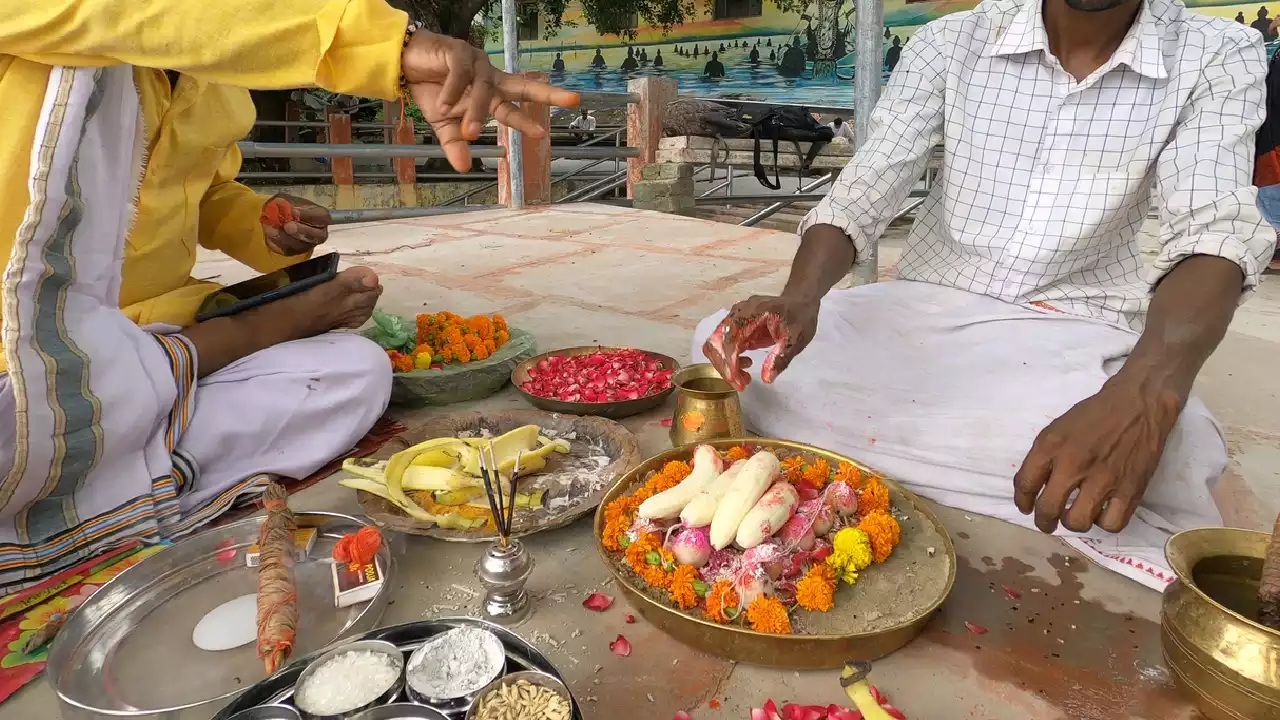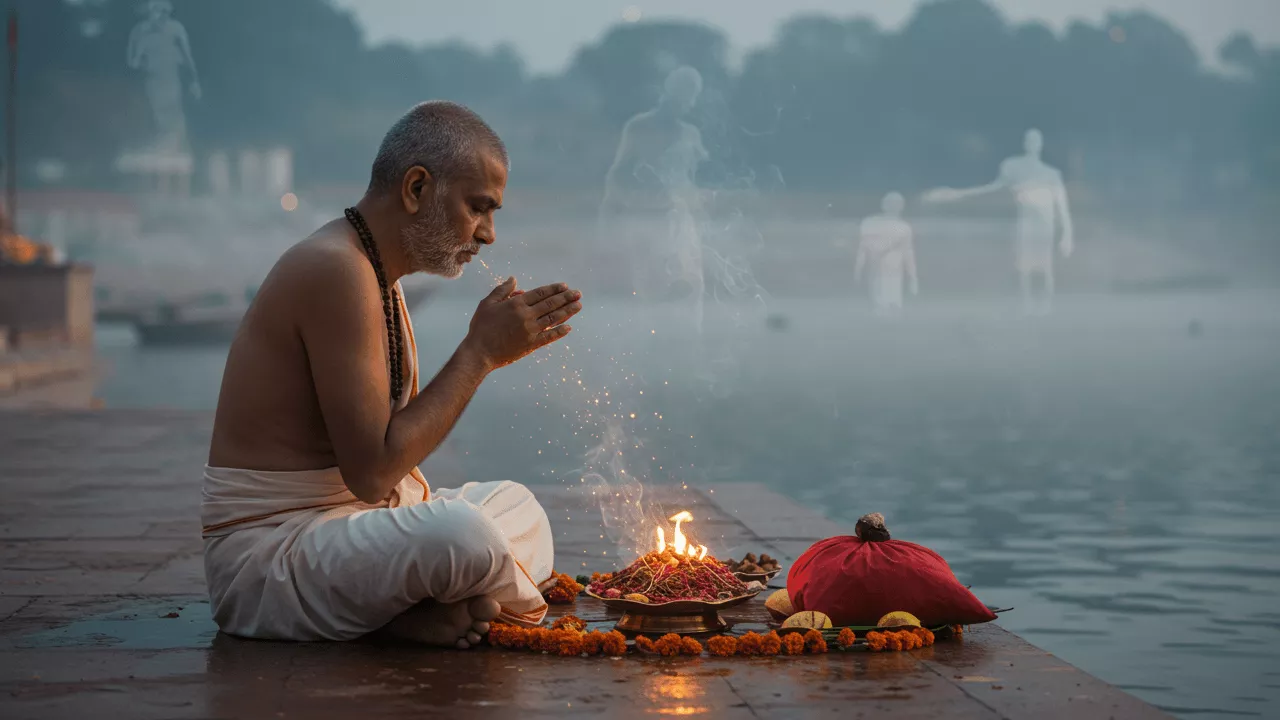Namaste,
Understanding the eligibility ensures these vital rites are performed correctly, bringing solace (shanti) to the departed ancestors (Pitrs) and merit (punya) to the performer (karta).
Who Can Perform Pind Daan? Understanding Eligibility Rules and Traditions
The act of offering Pind Daan is a sacred thread connecting generations, a duty (dharma) and a privilege. Our scriptures lay down a clear order of precedence, ensuring that someone is always available to perform these essential rites for the well-being of the departed souls.

The Primary Torchbearers: The Male Lineage (Purush Vansh – पुरुष वंश)
The foremost responsibility and right to perform the obsequies (antyeshti) and subsequent Shradh rituals, including Pind Daan, rests traditionally upon the male descendants of the departed. Think of it like passing a sacred lamp from one generation to the next.
- Son, Grandson, Great-Grandson (Putra, Pautra, Prapautra – पुत्र, पौत्र, प्रपौत्र): The Puranas consistently name the son, grandson, and great-grandson as the primary individuals authorized (adhikari) to perform these rites. The Garuda Purana is quite explicit, listing the son, grandson, great-grandson, followed by his brother, the brother’s progeny, and other sapinda relatives (those connected by the offering of the pinda) [Garuda Purana].
- The Son’s Precedence: The son (putra) holds a special place. He offers Shradh even if his own father is alive (in which case, he offers to his grandfather and great-grandfather, bypassing the living father). The crucial Sapindikarana rite, which formally unites the recently departed soul (preta) with the collective ancestors (pitrs), is principally the son’s duty for his father [Garuda Purana].
- Elder Son’s Role: If there are multiple sons, often the eldest son (jyeshtha putra) takes the lead in performing the main funeral rites, though all sons share the responsibility and merit. If the family property is divided, scriptures mention that other sons might perform Shradh separately [Source likely Smriti texts referenced in Puranas].
- Limitations: However, the scriptures also note distinctions. Certain types of sons acknowledged in ancient society (like Ksetraja – son born of wife by appointed kinsman, Sahodha – son already in the womb of the bride at marriage, Kanina – son born to an unmarried damsel, etc.) were considered primarily nominees and might not have the full authority to perform rites that absolve ancestral debt through pinda offerings [Source Puranas like Vamana, Garuda]. A Shradh offered by certain others, like a Jarajata (adulterine son), might also be deemed invalid [Source Puranas]. The Garuda Purana also notes that a son becomes entitled to perform his father’s Shradh after his Kesanta ceremony (first cutting of the hair, signifying a stage of Vedic study), though he might not recite the full Vedic mantras until later initiations [Garuda Purana].
This emphasis on the male line stems from ancient socio-religious structures where the son was seen as ensuring the continuity of the lineage and its ritual obligations.
When the Lamp Needs Relighting: Provisions for Absence of Sons (Putra Abhav mein Adhikari – पुत्र अभाव में अधिकारी)
But what happens, if destiny unfolds differently and there is no son, grandson, or great-grandson available? Does the duty remain unfulfilled? Our compassionate Shastras provide alternatives, ensuring no soul is left without solace. The eligibility for who can perform Pind Daan extends further.
- The Wife (Patni – पत्नी): In the absence of a son, the wife of the deceased is given significant authority. The Garuda Purana explicitly states the wife can perform rites like Vrsotsarga (ritual release of a bull, often done during Shradh) [Garuda Purana]. Crucially, for the Sapindikarana rite, if there is no son, the wife is empowered to perform it [Garuda Purana].
- The Daughter’s Son (Dauhitra – दौहित्र): He holds a special place, often considered equivalent to a son in many ritual contexts. If there is neither son nor wife, the daughter’s son is a primary candidate [Garuda Purana].
- The Daughter (Putri – पुत्री): In the absence of the above, even the daughter herself is permitted to perform rites like Vrsotsarga according to the Garuda Purana [Garuda Purana]. While traditionally less common for performing the core pinda rites, her role is acknowledged, especially in specific circumstances or traditions.
- Brothers and Nephews (Bhrata aur Bhatija – भ्राता और भतीजा): If the wife is also unavailable, the deceased’s elder or younger brother, or the brother’s son (nephew), can perform the Sapindikarana and other rites [Garuda Purana]. Manu’s wisdom, echoed in Puranas, suggests that if even one among brothers has a son, that nephew is ritually considered a son to all his uncles for these purposes [Source Puranas referencing Manu].
- Other Relatives (Sagotra/Sapinda – सगोत्र/सपिण्ड): Close relatives (sapindas – those within certain degrees of blood relation sharing pinda offerings, or sagotras – those sharing the same ancestral lineage/Gotra) can step in if the immediate line is absent [Garuda Purana]. They often participate by touching the body, offering water libations (jalānjali), etc., even when the primary performer is present.
- Disciple (Shishya – शिष्य): In the absence of any relatives, a devoted disciple can perform the obsequies and even the Sapindikarana rite [Garuda Purana]. This highlights the importance of the spiritual bond.
- Self-Performance (Swayam Shradh – स्वयं श्राद्ध): If absolutely no one else is available, scriptures allow an individual to perform certain rites for themselves during their lifetime (Jeevat Shradh) to ensure their own well-being after death.
- The Sonless Person Caution: It is worth noting, however, the Skanda Purana‘s poignant cry that a sonless person (aputra) himself should ideally not be engaged as the primary guest Brahmin in someone else’s Shradh rite, reflecting the deep societal value placed on having progeny for these duties [Skanda Purana].
This expanded circle shows the Shastras’ intent: the sacred duty must be performed.

The Role of Brahmins: Facilitators and Representatives (ब्राह्मणों की भूमिका)
Brahmins play a crucial role in Shradh, both as officiating priests (purohits) who guide the karta (performer) and as respected guests invited to represent the ancestors and receive the offerings (bhokta).
- Qualities of Invited Brahmins: The Puranas meticulously list the qualifications for Brahmins worthy of invitation. They should possess Vedic knowledge (like the Trisuparna hymns), know the Vedangas, be adept in rituals (like the five sacred fires), be disciplined, austere (tapasvi), devoted to parents, of good family (kula), and virtuous conduct [Sources like Garuda, Skanda Puranas].
- Regional Traditions: Interestingly, some texts like the Skanda Purana mention regional preferences, stating that in areas like Nagara, local Nagara Brahmins should be preferred even over more learned outsiders, lest the rite become futile [Skanda Purana]. This shows the interplay of broad principles and local customs (deshachara).
- Conduct Over Knowledge: However, the Skanda Purana also wisely cautions against inviting a Brahmin lacking good conduct (sadachar) and learning, even if he knows the texts theoretically. It prioritizes Brahmins of good family and conduct, even if their learning is less extensive [Skanda Purana]. Purity, virtuous habits, and lack of physical defects are emphasized [Skanda Purana].
Caste Considerations: Dharma and Devotion (वर्ण धर्म और भक्ति)
While Shradh rites are primarily associated with householders (grihastha) within the traditional Varna system, the picture regarding who can perform Pind Daan across different castes has nuances.
- General Rules: Impurity (ashaucha) due to death applies across castes. Certain complex Vedic initiations (yajñopavīta) and sacrifices were traditionally the domain of the dvija castes (Brahmin, Kshatriya, Vaisya). Presiding over or teaching scriptures for a Shudra’s Shradh might have restrictions for Brahmins in some orthodox views.
- Broader Eligibility and Devotion: However, scriptures also show inclusivity. The Skanda Purana allows people of all castes (sarva varna) to offer water libations (tarpan) to Bhishma during Bhishmashtami [Skanda Purana]. The Siva Purana strongly emphasizes devotion (bhakti), stating that anyone, regardless of caste or past sins, can attain high goals through proper initiation (Sivadiksha) and devoted worship. For Shudras devoted to Siva, purification is possible, and simple acts like bowing (namaskar) can fulfill ritual requirements [Siva Purana]. These examples suggest that while specific ritual complexities might vary, the path of devotion and adherence to certain traditions can broaden participation.
The Performer’s State: The Most Crucial Eligibility (Karta ki Yogyata – कर्ता की योग्यता)
Beyond lineage, caste, or even who is technically authorized, my child, the inner state and conduct of the person performing Pind Daan is paramount. This is a point the Shastras stress repeatedly.
- Essential Virtues: The performer should be vigilant, continent (observing celibacy on the Shradh day), gentle, calm, truthful, sober (not intoxicated), and maintain silence (mauna) during key parts of the ritual [Source Puranas].
- Faith and Devotion (Shradh aur Bhakti – श्रद्धा और भक्ति): This is non-negotiable. A rite performed without faith and devotion is deemed futile (nishphal), and the performer is considered an unbeliever (nastik). The offering must come from the heart.
- Knowledge and Resources: Knowing the proper procedure (vidhi) – ideally learned from a preceptor (Guru) – and having the necessary resources acquired through righteous means (nyaya) are essential. Ill-gotten wealth used for Shradh only benefits ancestors in lower births [Brahma Purana, Markandeya Purana].
- Purity and Initiation: Physical and mental purity are vital. Proper initiation (Diksha) is often mentioned as necessary for grasping the subtle energies (Shakti) involved in rituals and mantras [Source Puranas like Linga]. Control over the senses (indriya nigraha) is also key.

Who Should Be Avoided: Disqualifications (Anarhat Vyakti – अनर्ह व्यक्ति)
Just as eligibility is defined, the scriptures also list individuals who should generally be avoided, either as performers (karta) or as invited Brahmin guests (bhokta) in a Shradh, as their presence or participation can mar the sanctity of the rite:
- Physical Ailments/Defects: Chronically ill persons, those deficient in limbs or having extra limbs, those with bad nails or black teeth [Source Puranas].
- Moral/Ethical Lapses: Fallen ones (patita), thieves, eunuchs, atheists (nastik), cheats, usurers, meat-sellers, those who obstruct their Guru, those who marry before an elder brother (parivetta).
- Lack of Vedic Observance: Those with matted hair who haven’t learned Vedas, those who don’t maintain sacred fires (agnihotra).
- Certain Professions/Statuses: Physicians (in some contexts), temple priests/idol-attendants (seen as living off deity’s offerings), traders, rustics, messengers, cattle breeders.
- Specific Family Situations: The husband of a barren woman, a sonless person (as primary guest), certain types of sons born outside wedlock (Kunda, Gola).
- Impure Observers: The Shradh food should not be seen by dogs, certain birds (fowl), pigs, or ritually impure/forbidden persons, as this renders the Shradh ‘Rakshasa’ (demonic) [Source Puranas].
- Offering to the Living: One must never offer Pinda to a person who is still alive.
This extensive list underscores the emphasis on ritual purity, ethical conduct, and adherence to social and religious norms for maintaining the sanctity and efficacy of Shradh.
Conclusion: Weaving Duty, Devotion, and Guidance
So, the answer to who can perform Pind Daan is layered. The primary duty rests with the son, grandson, and great-grandson. Yet, the compassionate wisdom of our Shastras ensures that in their absence, the wife, daughter’s descendants, brothers, relatives, and even disciples can fulfill this sacred obligation.
More important than mere lineage, however, is the performer’s own state – their faith, purity, ethical conduct, and adherence to the prescribed methods learned from a reliable Guru or purohit. It is the combination of correct lineage (or authorized substitution), proper procedure, and sincere devotion that makes the Pind Daan truly effective, carrying our love and sustenance to the Pitrs.
Always approach these sacred duties with humility, reverence, and the guidance of tradition (parampara). May your devotion bridge the worlds and bring peace to all.
|| हरि ॐ तत् सत् ||
